This was published 4 years ago
More than a million travellers visit the Maldives each year. Here's what they don't see
By Jane Richards
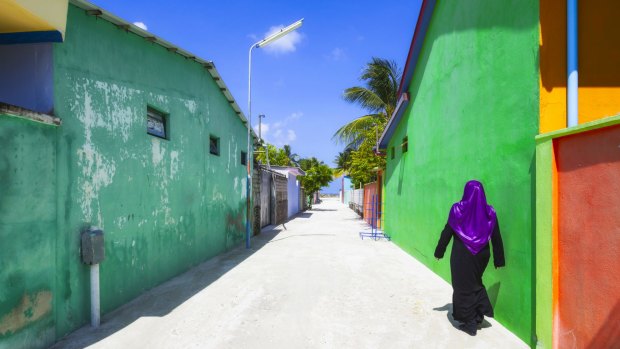
Colourful buildings in Male. Credit: iStock
It's a starry, starry night, yet even the diamond-studded skies of The Maldives have competition. Phosphorescence, that fleeting yet magical phenomenon is making the water beside our wooden boat, or dhoni, sparkle.
And now there's an even bigger distraction.
One of us has caught a fish. Then my small handline jolts. I've caught one, too. Then three. And another. Two more. The air is charged as the six of us haul in fish after fish. It's another first for us in 24 hours of firsts we are unlikely to forget.
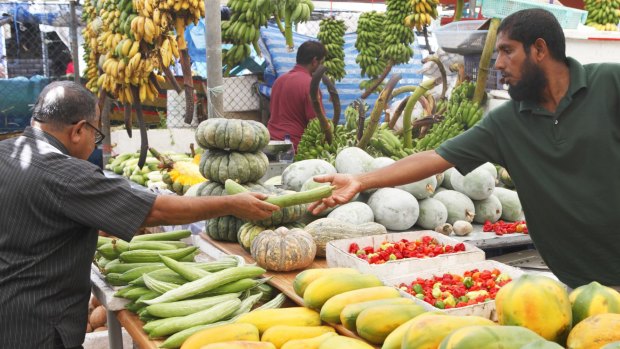
A market in the centre of Male.Credit: iStock
We are sampling island life, Maldives-style. But we are not talking about the rarefied yet somewhat static comforts of an overwater bungalow. We are here to explore the other side of The Maldives, by visiting the capital, Malé, and staying on one of the non-resort-inhabited islands that help make up this drops-in the-ocean nation. While more than 1.5 million people visit the Maldives each year, it's a side almost 80 per cent of them don't opt to see, and that's a pity. After all, have you really visited a country if you just stay in a resort?
TO THE ISLAND
There are not too many airports in the world where you can walk outside the terminal at 10pm, cross the road and board a speedboat, a la James Bond. But in this nation of 26 natural atolls and about 1190 islands and sandbanks, water is the highway to everywhere. We are heading about 20 kilometres from Malé, to Gulhi, one of the inhabited islands of Kaafu Atoll in South Malé Atoll.
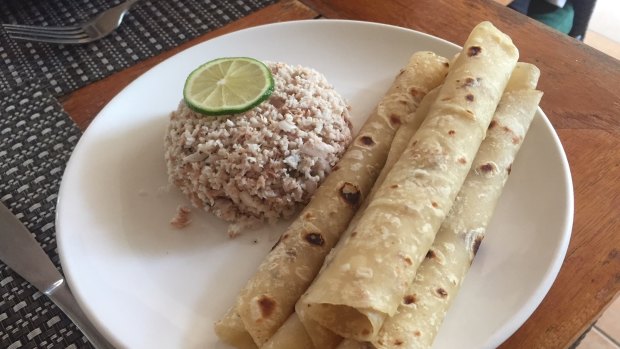
Mas huni.
We are only in The Maldives for six days and are keen to mix it up with a few nights at a small family hotel on this island, side trips to Malé, sampling life aboard a live-in boat and ending with a stay in a resort.
It's an itinerary that was rare until recently, but thanks to a push by Maldives tourism authorities to encourage people to experience attractions beyond those on the brochures, it's one that's never been easier. Visit Maldives says that while the "one island one resort" concept established The Maldives as a landmark of luxury, "people forget we are more than that. We have a history which molded our rich culture that is unique in each island".
Venturing outside those Insta-worthy resorts, many of which are leased by foreign-owned companies on 99-year contracts, is a win-win: visitors gain a greater knowledge about this part of the world and locals get to share in the travel dollar. And many resorts, too, are embracing a new thirst for authentic experiences among their guests by offering day trips to non-resort islands, selling local products in their gift stores, highlighting local festivals like Eid, and encouraging guests to pitch in or learn about local ecological projects like coral regeneration.
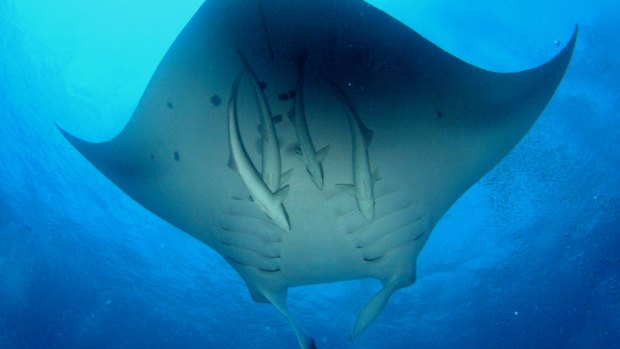
A manta ray.Credit: Alamy
We are unsure what to expect as we zoom along on this late-night adventure. The night is warm, the skies clear, and the trip is the perfect antidote to many hours in the air. As we walk across the sand on the deserted beach, a blue-lit "Welcome to Gulhi" sign decorated with coral and shells blinks a hello, as do our hosts who are bearing an equally bright blue welcome drink (it's non-alcoholic: The Maldives is a strict Islamic nation and alcohol is not allowed except for on the resorts). We walk to our small hotel and crash.
An early call to prayer the next morning is hauntingly beautiful but squawking birds and delicious smells from the kitchen in the quaint and pretty Tropic Tree Hotel are the best alarm clock. An early walk shows it's not hard to get your bearings - the island is just 400 metres long and 225 metres wide.
Our hotel is surrounded by pastel houses – blue, pink, green – with hand-drawn carts parked on the sandy street in front of some of them. A few are splashed with graffiti art, others are offset by coral stone walls. Children can be heard singing at school and women in head scarves wave as they pass.
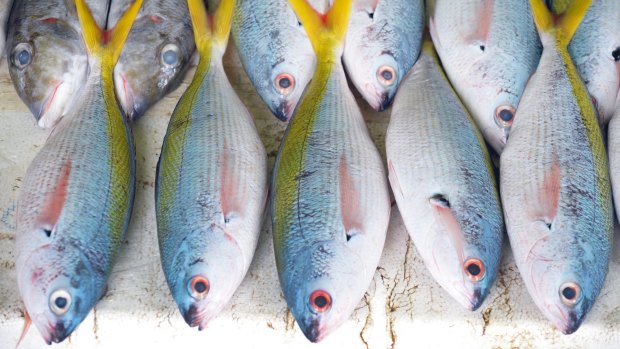
Rows of brightly coloured fish displayed for sale in a Male fish market.Credit: iStock
Breakfast is in the hotel courtyard which is decorated with the owner's art works. Omelettes and toast are on the menu but so is mas huni. This Maldivian specialty – a mound of finely diced cooked tuna, coconut, chilli and red onion with added salt and lime juice – is served with rolled roshi bread. We are instantly hooked, much like the ubiquitous yellow-fin tuna which we discover is a staple throughout The Maldives. After a short boat ride the next day, a giant yellowfin even joins us as we snorkel on a coral reef. He may be lost, however, because he appears outnumbered by the schools of unicorn, parrot, vampire and blue trigger fish we swim through.
We have become experts in identifying fish thanks to our local guides from Secret Paradise Maldives. The local company provides authentic and sustainable experiences for guests who want to get more out of holidaying somewhere that, for most people, is a once-in-a-lifetime destination.
All Secret Paradise guides are Maldivian and they are funny, charming and knowledgeable about the reefs. They are also excellent snorkellers, though we can't work out how one of them can dive so effortlessly and spend such a long time at the depths pointing out turtles, coral and giant clams and yet still smoke Camels with his coffee back at Gulhi.
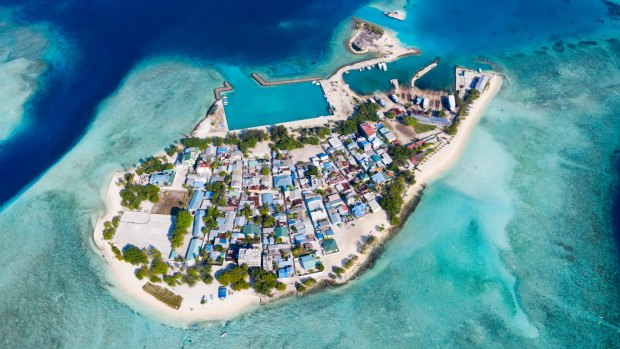
Gulhi, South Male Atoll.Credit: Alamy
Gulhi Island has a beach for locals, and another - Bikini Beach - for visitors. Both have white fine sand and turquoise waters.
There are plenty of snorkelling reefs just a short boat ride away, or you can spot coloured fish straight off the island. Manta rays on one side of Gulhi attract divers, and dozens of stingrays provide a small nightly show as they glide back and forth over submerged rocks off the pier.
But the daily life on Gulhi's tiny terra firma is just as unique. It might only take a short walk to cover the island but there's a lot to see.
Fishing boats arrive and depart and other much larger boats are patched and painted in the busy shipyard, where traditional wooden dhonis are also made.
Rope swing seats - a common sight throughout The Maldives - sway in the breeze along the beachfront and under shady trees. Women with young children meet on them in the early mornings; older people meet to chat on them in the evenings and children play on them in the afternoons. Warning: once you sit – it's hard to stay awake.
Across from the beach, soccer is played by men in non-shirts versus shirts teams. As we turn a corner we catch another game in progress - women's volleyball. The play is fierce and the players are athletic; their headscarfs, long sleeves and long pants don't seem to hinder them, despite the heat.
There's a small market run by older women selling trinkets, bowls and necklaces and a cafe where we sample hedika, which are Maldivian sweet and savoury treats. The selections includes bajiya (tuna, onion, pepper and lime), kawabu (more tuna, this time smoked, plus onion, turmeric and curry leaves) and gulha (yes, tuna, with onion, lemon, chilli peppers, ginger and coconut), all served with black tea. It's a festival of tuna, yet somehow each delicacy tastes remarkably different to the others.
Local religious custom dictates that you dress modestly on non-resort islands – and this includes when you are swimming, are on your way to swim, or are returning from a swim. This means, for women, covering arms, legs and hair, and ensuring anything worn over your bathers is not see-through. The upside? Instant sun protection. The downside? It can be hard to remember or to even realise you are not completely covered until you leave your room - we often have to dash back to grab a scarf or sarong on our way out for a snorkel or a swim.
This is also a close-knit community. We notice how the very old and the very young are out and about together, and how everyone keeps a close eye on young children, even our guides pause mid-sentence to sprint to help a small girl who has sand in her eyes. And we're told it's near impossible to live here on feast days without being offered meals by friendly locals many times over.
WHAT MALDIVIANS AND MELBURNIANS HAVE IN COMMON
But if island life sounds too chilled out – there's always the capital. For a city of just 133,000 people, Malé is bold and bustling, rich in culture, history and art, and it's easily accessed by ferry from Gulhi and other islands. The streets are full of bikes and cars and pedestrians yet it's easy to walk around.
For sheer spectacle, don't miss the fish market on the harbour where multi-coloured catches are brought throughout the day and displayed on the tiled floor. And yes – there are many varieties of tuna. But the real star of the show stands at a bench in the middle of the market. This Edward Scissorhands of the fish world is a giant of a man in a plastic apron who, with knives flying like knitting needles, fillets fish on request with all the expertise of a sushi master.
The nearby fruit and vegetable market is a scream of colours, smells and unrecognisable foodstuffs. We are handed fresh coconut water and then asked to try dried tuna, smoked tuna (yes, it becomes addictive after a while) and the Maldivian go-to treat – the very moreish Huvadhoo Bondi – a long stick of sugared coconut deliciousness.
We visit the President's Palace and the gold dome-topped Grand Friday Mosque, the Maldives' biggest modern place of worship. But the standout is the Old Friday Mosque. The fact that it was built from interlocking slabs of dead coral in 1656 is mind-boggling enough, but the real-surprise is close-up, where you can see the row upon row of neat Quranic script and elaborate decorations that have been chiselled into its walls. In the grounds are ancient tombstones (the round-topped ones are for women; the pointy ones for the men).
It's hot and, as mentioned, The Maldives is "dry" outside resorts so where better to go for refreshments than the local cafe. Coffee is the drink of choice here and it's hard to differentiate a Maldivian from a Melburnian when it comes to knowing your flat white from your piccolo. The garden tables at the Royal Garden Cafe – ganduvaru or nobleman's house - are already full by the time we arrive mid-afternoon so we head into the dark timber interior for machiattos, espressos and ice coffee. Groups of friends, couples and solo imbibers chat at tables as they name their poisons.
THE PEOPLE OF CORAL
Our last stop in Malé is the National Art Gallery in Sultan Park. It features a photographic exhibition involving another subject close to Maldivian and Australian hearts – coral reefs. The White Fire: The plight of coral reefs by conceptual and fashion photographer Mohamed Azmeel, known as Double Dot, depicts Maldivians as "people of coral" living in a marine ecosystem made fragile by global warming.
The hauntingly beautiful images of faces morphed into dead coral highlight the real concerns faced by this island nation and calls to mind another island just off Malé.
Villimale (also known as Villingili), south-west of the capital, should be dubbed miracle island. Just a few years ago it was completely overrun by plastic. Rubbish covered its beaches and if you did brave the water you would have rotting food and waste as companions. Visitors avoided the area and locals learned to put up with it because the scale of the problem seemed insurmountable.
But thanks to the efforts of local NGO Save the Beach, supported by companies such as Secret Paradise, the island has been transformed to such an extent that it's now on visitor itineraries as a good place for a day trip or a swim. It also attracts others keen to see how such an effective transformation could take place so quickly.
Such has been the interest that Secret Paradise has developed an island-hopping tour that enables guests at resorts or local islands to volunteer for short periods or learn about the work being done here.
We take a guided walk around the quiet streets of Villimale (only electric cars are allowed here) with the dreadlocked driving force behind Save the Beach, Hassan Ahmed – known as "Beybe".
We watch women tend beachside gardens, spot crabs darting on white sand, sway on rope swings, have a straw-free iced coffee at a beachside cafe, laugh with locals who play carom - a snooker-like board game - and hear more about how the success of a reef restoration program here that is contributing to worldwide scientific knowledge.
It's inspiring stuff.
But back to our night on that small fishing boat.
Our haul of 30 or so good-sized fish is doubly thrilling because we are sharing it with a local family who have invited us over for dinner.
As we arrive at the small house we nod and smile as the three generations guide us to a long table covered in plates of food.
We might not be able to communicate, but their beautifully-prepared curries, pickles, breads and vegetable dishes, and our load of cleaned fish, does that for us.
FLOAT YOUR BOAT
The scenery is moving. A whiter-than-white sand island bobs like a lost pearl ahead of our boat as Gulhi's pastel-coloured houses fade from view. The vote is unanimous – we'll drop anchor here, make some Robinson Crusoe footprint trails, and then swim in every shade of blue before heading off to another breathtaking spot.
This is yet another way to see The Maldives - by boat, or, as we like to think of it, on an overwater bungalow that moves. The benefits are many. Why resort to just one resort, when you can sample the offerings of many? Why not switch gears from snorkelling to a surf break? Or mix up the swim-eat-snorkel, swim-eat-snorkel cycle with a flying trip by tender to Malé's art gallery, bustling markets, ancient sites and coffee houses. It's the perfect getaway while you're on a getaway.
This is good non-resort choice for those who like to imbibe – the non-drinking rule doesn't apply on vessels that are at least a kilometre from shore.
We sample two options: the Dhoni Stella 2, a private wooden boat built in traditional Maldivian style, and the Over Reef, a luxury yacht that set sail for the first time last year. Tariffs on both of these Yacht Maldives vessels include all food and staff, so there's no need to shop cook or clean.
The Over Reef has three guest cabins, one with an ensuite. There's a lounge and no internal stairs so it's perfect for families or those with mobility issues, but the real bonus is the flybridge with a barbecue, sofa deckchairs and awning. There's a platform for fishing and scuba diving and a large motorised tender that can zip you to a dot in the ocean to snorkel, to Malé for a quick curry, or to a nightclub at a resort island.
The Dhoni Stella 2 is in front by a nose in my book. Built in 2007, it has all the classic beauty of an antique dhoni with the best that contemporary boats offer. There are two cabin suites catering for up to six passengers. It would be ideal for a couple on a special anniversary, a family with teens wanting a last trip together before adult life takes over, groups of friends or a bunch of surfing mates (the Pasta Boy break on North Malé Atoll made famous by the late Australian-born Maldivian surfer Tony Hussein Hinde is a favourite).
The wooden interiors are a nod to the history of the classic Maldivian dhoni, a style of boat believed to have been modelled on the the traditional Arab dhow, and the large cabin windows offer fresh air and amazing bedside views.
These boats are only hired out on a one-party basis so you won't be sharing with others. And the yacht owners don't rule the waves when it comes to itineraries. You can either follow one suggested by Yacht Maldives or devise your own.
THE MALDIVES, THE FACTS
THIS TINY NATION IS…
1. Made up of 99 per cent water
2. The smallest Muslim nation in the world
3. The smallest Asian nation in the world
4. 100 per cent Muslim
5. the lowest and flattest nation in the world. The highest point is on Villingili Island at just 2.3 metres.
ISLANDS SURVIVAL KIT
1.Dress modestly on non-resort islands. This means covering arms, legs and hair for women, wearing one-piece bathers and covering up to, from and on beaches.
2. Take a small amount of local cash with you to island villages to spend at markets.
3.BYO sunscreen. It's expensive here and a bottle can cost up to $100 on resort islands.
4.When it comes to food try everything, including mas huni (tuna, chilli and coconut) for breakfast. It's addictive.
5.The Maldives is a "dry" country outside the resort islands. This means no alcohol so don't stock up on Duty Free on your way in.
TRIP NOTES
Jane Richards was a guest of Maldives Tourism visitmaldives.com and Secret Paradise secretparadise.mv
MORE
Singapore Airlines and Sri Lankan Airlines fly to the Maldives from Australia. See singaporeair.com and srilankan.com
STAY
A stay at the Tropic Tree Hotel on Gulhi Island can be organised through booking agents or through Secret Paradise. Rates from about $123 per night. The luxury Yacht Maldives Over Reef rates start from $1900 per night, maximum of six on board; and Dhoni Stella 2 is from $1300 per night. Price includes all food and soft drink, staff on board, Wi-Fi, fuel and a pick-up from Malé airport.
VISIT
Stays, visits or volunteering trips on Gulhi Island, Villimale or other non-resort islands in The Maldives can be organised through visitmaldives.com or Secret Paradise. See secretparadise.mv The White Fire exhibit will be at Jumeirah Vittaveli, The Maldives, until February 15, 2020.
Sign up for the Traveller Deals newsletter
Get exclusive travel deals delivered straight to your inbox. Sign up now.